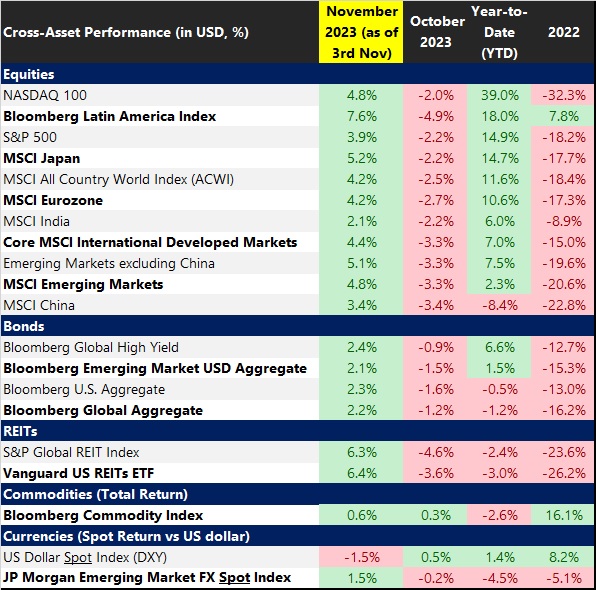Till the end of October 2023, i.e., for the first 10 months of the year, the US Aggregate Bond Index was down almost 2.8% for the year.
As of last Friday, i.e., 3rd November 2023, it was down just 0.5% year-to-date.
So, what happened in just 3 days?
After all, a 2.3% move in half a week is significant even for equity indexes, let alone a supposedly stable US bond index.
Before getting into the details, let me broadly explain what caused long-term bond yields to decline.
As you know, when bond yields (or interest rates) go down, bond prices go up. Therefore, the upswing in the bond index actually reflected the decline in yields, especially for the 10 and 30-year bonds.
And why did these yields go down?
Because a number of macroeconomic indicators on economic activity and the labor market showed signs of a slowdown.
This was considered good news, as the Federal Reserve had desired this outcome. So if the economy slows down, the Federal Reserve (the Fed) was unlikely to raise rates and might cut interest rates sooner than expected. That's how the markets' logic went.
However, macroeconomics is a reflexive science, where things move in endless feedback loops.
Actions undertaken by central banks affect what happens in the economy and the markets, which, in turn, influences what central banks like the Fed, do. And on and on it goes.
During last week's meeting, the Fed was considered less hawkish on raising rates than before.
But what it actually said was this: They may not need to raise rates much because the market was doing the job for them by raising long-term yields, and other financial market indicators also showed tightening.
However, this statement itself brought long-term yields crashing down, which may, in turn, cause the Fed to become more hawkish.
The rates coming down and bonds rallying were also accompanied by rallies in other asset classes. In the past week, ETFs tracking stocks, government bonds, and corporate credit recorded their biggest weekly cumulative gain since November 2022. Even Emerging Markets, which have been relative underperformers, rallied.
Recently, correlations across asset classes have been positive not only during sell-offs but also in rallies, limiting diversification benefits.
Here's a snapshot of the recent performance:

Source: Bloomberg, First Global
Data as of November 3, 2023
In the first three days of November 2023:
What drove the rally?
Let’s dive into the sequence of events that led us to this wave of buying across assets:
For context, in the prior quarter i.e. Q3 2023, the treasury increased its net borrowing estimate to $1 trillion, well up from the $733 billion amount it had predicted in early May. The issuance jump for Q3 had pushed 10-year treasury yields higher by 100 basis points (bps) to 4.93% in 3-months.
While the drop in bond issuance from that high a level was taken as a positive sign, it still remains very elevated relative to history.
Consequently, we witnessed a 10 bps drop in 2-year treasury yields to 4.84%, the lowest level since August 11 as the market moved to price in 100 bps of rate cuts by the end of 2024.
All these indicators showed that labor market was not as robust as earlier thought.
Since labor market tightness was one of the reasons for the Fed to raise interest rates, the cooling down reinforced expectations of a looser monetary policy, subsequently boosting prices in equities, bonds, and credit.
The all-important question: What's next?
The combination of the above-discussed data points has sparked hopes for a "Goldilocks" period -- a scenario where the possibility of ending rate hikes is considered in light of softer economic data, all while avoiding a full-fledged recession in the US economy.
Additionally, the size of the move in a fairly short period suggests a decent amount of short-covering as well.
Still, two key risks remain.
The Reflexivity Trap
Fed Chair Powell explicitly mentioned that he closely monitors multiple financial conditions indices. These indices take into account the movement in stocks prices, bonds yields, and credit spreads among others.
In his earlier press conferences, he stated that if the markets and financial conditions tighten, the Fed may need to raise rates by a much smaller amount because the macroeconomic consequences of tightening financial markets or the Fed increasing rates are the same.
If the current cross-asset rally continues, financial conditions could substantially loosen, potentially altering the Fed's policy stance and keeping rate hikes on the table.
Source: Bloomberg, First Global
Therefore, there is an implicit cap on the rally that can be expected from risky assets such as equities and corporate credit.
A greater than expected Economic Slowdown or Recession
Logically, the only way the Federal Reserve may refrain from considering any additional rate hikes or even potentially cut interest rates starting in the first half of 2024, is if the softer economic data does not stabilize and, in fact, deteriorates significantly.
But that will be bad news for corporate earnings and corporate credit.
Currently only scenario building and probabilities are possible. Making a firm prediction on how things pan out is not.
From Your Friends at First Global
If you want any help at all in your wealth creation journey, in managing your Investments, just drop us a line via this link and we will be right by your side as your wealth advisor, super quick!
Or WhatsApp us on +91 88501 69753
Chat soon!


Economists Think Dollar's Fall May Explain the Recent ‘Rally’ by Steve Liesman
Einstein taught us about relativity in nature. Now come Devina Mehra and Shankar Sharma of First Global to teach us about relativity in financial markets -- and raise some serious questions about just what is driving stock prices.

First Global reports are quite credible and, on occasion, more than that.
What prompts this mention is Intel's earnings report and the fact that First Global has had a pretty good bead on the company and its stock.

AMD up again following First Global upgrade to ‘buy’ (AMD) By Tomi Kilgore
Analyst Kuldeep Koul at First Global upgraded Advanced Micro Devices (AMD) to "buy" from "outperform," given the "exceptional traction" that the chipmaker's Opteron line of processors has been able to get.

Baidu Climbs on First Global’s ‘Outperform’ Outlook
Baidu Inc., the operator of China’s most-used Internet search engine, rose to the highest price in two weeks after First Global rated the shares “outperform? in new coverage.

Personality counts: Walmart's frugal, but Target charms
"It's better to take a slight hit on [profit] margins and keep on moving and inventing," says First Global Securities. And at least for now, Target is inventing in a way that appeals to consumers with money to spend.

Dead Batteries
At 11 times trailing earnings, Energizer is cheaper; Gillette's multiple is 25. But cheaper doesn't mean better, says First Global.

Bipinchandra Dugam @bipinchandra90
@devinamehra @firtglobalsec
invested in both GFF-GTS and Super I50. Thank you very much for such wonderful investing experience with completely new approach. In my 15years of investing first product I felt which close to what customer want.

Shishir Kapadia @shishirkapadia1
@firstglobalsec @devinamehra
by far you are the best, I have not come across transparency, acumen, global expertise, exposure, protection of capital, delivering return from any fund/ fund managers. Invested very small size in 3 products will keep on increasing it over the period

Piyush Bhargava @PiyushB88762654
@devinamehra @firstglobalsec
Thanks you team FG specially Devina, my investment doubled in less than 3 years in SDPB As a investors & PMS distributor of your product looking to have a long-term relationship with the company.
@KarmathNaveen the person with whom I always interact

Sumeet Goel @GoelSumeet
Very happy & relaxed to be invested with first global pms

Shishir Kapadia@shishirkapadia1
Congratulations on super performance, above all transparency and systematic process are unmatchable.
One must opt this, if person consider him/her self as an investor. Very happy to be part of this since invested. FG has managed worst year (ie 2022) so efficiently and skillfully.

SY @SachinY95185924
With so much of volatility in the market, risk management is very important part & considering that FG is doing awesome work!!! Kudos to you Chief

Amit Shukla @amitTalksHere
Truly outstanding. As a retail subscriber to #fghum #smallcase, I can vouch for the Nifty beating returns (8% vs 3%) in last 1 year. Keep up the awesome work @firstglobalsec
We can load above testimonials on site as a scroller, and just below that we can add a section for compliments . Below tweets are comments and praises are related to our content, performance and some our direct compliments to you.

ADIT PATEL @ADITPAT11226924
Good team...
Special mention @KarmathNaveen .. he is soo helpful anytime of the day or night..

Hindustani @highmettle
Bought Peace with FG-Hum.Moving all funds from DIY investing to well managed and diversified PF at low cost.
It has doubled almost, excellent pick.Every small investor must invest in her FG-HUM Smallcase.

Suresh Nair @Suresh_Nair_23
I have 8 small cases and your has been the most rewarding ones .. thank you Devina.

Sayed Masood @SayedM375
There is absolutely no doubt that she is one of the best investors of India in modern times but more importantly, she shares the most sincere and sane advice with retail investors.

SY @SachinY95185924
Wow Superb Returns🔥 Congratulations Chief for being Number 1 among all PMS!!!
You are one of the sharpest mind in Global Stock Market

AnupamM @moitraanupam
Congratulations Devina, results talk in itself!

Abhishek @simplyabhi21
Congratulations ma’am @devinamehra ! The consistency you have in maintaining the top rank position is outstanding! 👏

Mihir Shah @Mihir41Shah
We are learning More about markets (& Life ) thanks to U than we learnt in our Professional courses.A BIg Thank You, Wish all get Teachers Like You!!

Sumit Sharma @MediaSumit
"The ability to be comfortable with being outside consensus is a superpower in investing...and in life." Devina ji hits the nail on its head!

Majid Ahamed @MajidAhamed1
Congratulations @devinamehra mam! All the best for long term returns as well.

Vinay Kumar @VinayKu05949123
This is the wonderful session I have ever attended till date. One of the most fruitful hour of my life. Devina madam, ur clarity on financial mkts is simply superb.The way u portray the facts supported by "data" about stock mkts is really astonishing.I will listen again.Thanks.

VIJAY @drippingashes
I loved to read your journey, insight and philosophy. It's a pleasure to read and know of your takes on market and life.

MNC🏹 @Focus_SME
Check & follow @devinamehra's timeline for lots of post debunking such rosy stories. Also, she gives amazing 🤩 sector directions/hints.

KLN Murthy @KLNMurthy2016
Good actionable insights, great article!

Suresh Nair @gkumarsuresh
Devina Madam is simply terrific... good knowledge, straight and simple thinking.
Very difficult to emulate such traits. I listen her past interviews from youtube.
Respect...!!!!

DD @AliensDelight
One of the brightest minds in the world of finance :)

Radhakrishnan Chonat @RCxNair
📣 Calling all investors! Just had an incredible interview with @devinamehra, Chairperson and MD of First Global. We discussed the importance of global diversification, effective asset allocation, and the risks of sitting on the sidelines. Trust me, you don't want to miss this!

siddarthmohta @siddarthmohta
Excellent performance. Flexibility is the key as you have mentioned it earlier also. Cannot have finite rules for infinite mkt opportunities.

Boom (বুম)@Booombaastic
To be honest, the insights which Devina madam brings in is very enriching..have learnt a lot from them...

Himanssh Kukreja @Himansh02428907
One of the most accurate analysts :)
I always look forward to you interviews mam

Abhijeet Deshpande @AbhijeetD2018
Madam, It is always a treat to read your insight, not only on business but on other topics also!!

Dada.AI @dada_on_twit
Thanks for this wisdom ma'am. Always love hearing your thoughts on everything equity. :-)

adil @zinndadil
Excellent points!
Can clearly feel this thread is a product of marination of many books and years of experience. 👍

Kamal thakur @Kamalgt10
Superb !!
Your knowledge, analysis & articulation is simply great 👍

Tanay @Tanay36232730
Follower on Twitter and Subsciber on YouTube of First Global, really helping me in my investment desicion. Thanks
Copyright 2019, All Rights Reserved. Developed By : Hvantage Technologies Inc. Maintain By : Aarav Infotech